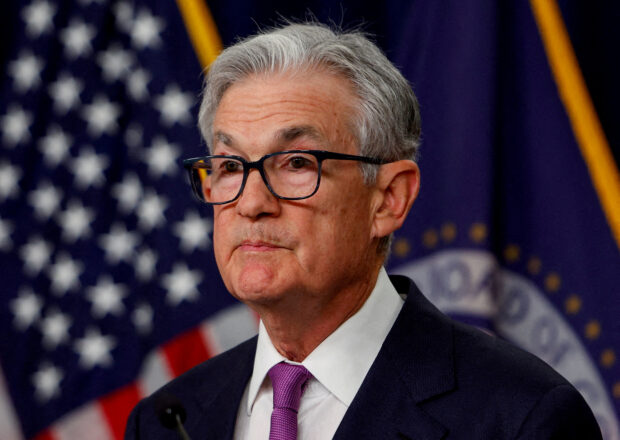LONDON – What comes after the pause? On Oct. 26, the European Central Bank snapped a 15-month streak of rate hikes by keeping borrowing costs on hold at a record high, echoing the recent actions of the Federal Reserve and the Bank of England.
The stage is now set for the world’s major rate setters to telegraph how long it will take them to declare their battle against inflation over and to start cutting rates, following the most aggressive monetary tightening cycle in decades.
So far, nine developed economies have raised rates by a combined 3,965 basis points (bps) in this cycle, starting September 2021. Japan is the holdout dove.
Here’s where central banks stand, from hawkish to dovish:
1) United States

U.S. Federal Reserve Chair Jerome Powell . REUTERS/Evelyn Hockstein/File photo
The Federal Reserve is expected to keep interest rates on hold at 5.25 percent-5.50 percent at its upcoming meeting, but is viewed as unlikely to soften its hawkish bias.
On Oct. 23, Fed Chair Jerome Powell said a strong economy and tight jobs market could warrant more rate rises. Traders see no significant chances of a cut until early summer 2024.
2) New Zealand
The Reserve Bank of New Zealand kept its cash rate at a 15-year high of 5.5 percent in May, but is seen as unlikely to cut it in November. New Zealand’s inflation hit a two-year low of 5.6 percent in the third quarter, still way above the RBNZ’s 1 percent to 3 percent target.
3) Britain
The Bank of England is expected to keep interest rates at 5.25 percent on Nov. 2 as it balances a weak economy with high domestic inflation and the potential for the Middle East conflict to cause energy price spikes.
Interest rate futures show traders believe the BoE will not cut rates, now at their highest since 2008, until at least June 2024.
4) Canada
The Bank of Canada held its key overnight rate at 5 percent on Oct. 25. Current market pricing suggests investors think further hikes are unlikely, but are not betting on cuts.
Inflation, which peaked at more than 8 percent last year, dipped to 3.8 percent in September, but the BoC also said price rises would not return to its 2 percent target until the end of 2025.
5) Euro zone
The logo of the European Central Bank (ECB) is pictured outside its headquarters in Frankfurt, Germany. REUTERS/Kai Pfaffenbach/File photo
The European Central Bank kept its key rate at 4 percent on Thursday, noting that the latest data continued to point to inflation slowly coming down to its 2 percent target.
“The Governing Council’s past interest rate increases continue to be transmitted forcefully into financing conditions,” the ECB said, adding it would follow a “data-dependent” approach and future decisions would be based on incoming data.
6) Norway
The Norges Bank raised its key rate by 25 bps to 4.25 percent in late September and hinted at another hike in December.
After September’s rate decision Norway’s inflation data for that month came in lower than expected. Prime Minister Jonas Gahr Stoere told parliament last week interest rates may have peaked.
7) Sweden
Sweden raised its main interest to 4 percent in September and has an unenviable decision about what to do next. Economists polled by Reuters see Sweden’s economy shrinking by 0.7 percent in 2023. Swedish inflation, excluding volatile energy costs, came in at an uncomfortably high 6.9 percent in September.
8) Australia
The Reserve Bank of Australia held rates steady at 4.1 percent for a fourth meeting in October. After surprisingly robust inflation in the third quarter, markets price around a 60 percent chance of a quarter-point hike next month. Governor Michele Bullock has also warned of further tightening if the inflation outlook worsens.
9) Switzerland
The Swiss franc hit its highest against the euro since 2015 on Oct. 19, after the outbreak of conflict in Gaza extended a long run of Swiss currency strength.
The mighty franc has helped the SNB control inflation, which at 1.7 percent year-on-year in September was comfortably within target. It also threatens Swiss exports at a time when the economy is stagnating.
Futures markets are tipping the SNB to hold its policy rate at 1.75 percent in December before assessing what to do next.
10) Japan
Japanese national flag is hoisted atop the headquarters of Bank of Japan in Tokyo, Japan. REUTERS/Issei Kato/File photo
The Bank of Japan concludes its next meeting on Oct. 31 after many months of standing firmly dovish in the face of surging global interest rates.
The BOJ has been intervening heavily in the nation’s bond market to keep yields below its 1 percent cap.
With pressure mounting on the BOJ to adjust this policy of suppressing domestic borrowing costs, bets are rising that it will have to tweak that 1 percent limit higher.

